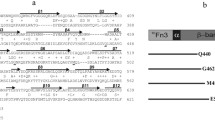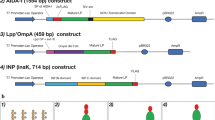Abstract
Cell-surface display using anchor motifs of outer membrane proteins allows exposure of target peptides and proteins on the surface of microbial cells. Previously, we obtained and characterized highly catalytically active recombinant oligo-α-1,6-glycosidase from the psychrotrophic bacterium Exiguobacterium sibiricum (EsOgl). It was also shown that the autotransporter AT877 from Psychrobacter cryohalolentis and its deletion variants efficiently displayed type III fibronectin (10Fn3) domain 10 on the surface of Escherichia coli cells. The aim of the work was to obtain an AT877-based system for displaying EsOgl on the surface of bacterial cells. The genes for the hybrid autotransporter EsOgl877 and its deletion mutants EsOgl877Δ239 and EsOgl877Δ310 were constructed, and the enzymatic activity of EsOgl877 was investigated. Cells expressing this protein retained ~90% of the enzyme maximum activity within a temperature range of 15-35°C. The activity of cells expressing EsOgl877Δ239 and EsOgl877Δ310 was 2.7 and 2.4 times higher, respectively, than of the cells expressing the full-size AT. Treatment of cells expressing EsOgl877 deletion variants with proteinase K showed that the passenger domain localized to the cell surface. These results can be used for further optimization of display systems expressing oligo-α-1,6-glycosidase and other heterologous proteins on the surface of E. coli cells.




Similar content being viewed by others
Abbreviations
- AT:
-
autotransporter
- EsOgl:
-
oligo-α-1,6-glycosidase from Exiguobacterium sibiricum
- 10Fn3:
-
human fibronectin type III domain 10
- PBS:
-
phosphate buffered saline
- pNPG:
-
p-nitrophenyl-α-D-glucopyranoside
References
Van der Maarel, M. J. E. C., van der Veen, B., Uitdehaag, J. C. M., Leemhuis, H., and Dijkhuizen, L. (2002) Properties and applications of starch-converting enzymes of the α-amylase family, J. Biotechnol., 94, 137-155, https://doi.org/10.1016/s0168-1656(01)00407-2.
Hua, X., and Yang, R. (2016) Enzymes in starch processing, in Enzymes in Food and Beverage Processing (Chandrasekaran, M., ed.) CRC Press, Boca Raton, FL, USA, pp. 139-170.
Dong, Z., Tang, C., Lu, Y., Yao, L., and Kan, Y. (2020) Microbial oligo‐α-1,6‐glucosidase: current developments and future perspectives, Starch Stärke, 72, 1900172, https://doi.org/10.1002/star.201900172.
Watanabe, K., Hata, Y., Kizaki, H., Katsube, Y., and Suzuki, Y. (1997) The refined crystal structure of Bacillus cereus oligo-1,6-glucosidase at 2.0 Å resolution: structural characterization of proline-substitution sites for protein thermostabilization, J. Mol. Biol., 269, 142-153, https://doi.org/10.1006/jmbi.1997.1018.
Watanabe, K., Kitamura, K., and Suzuki, Y. (1996) Analysis of the critical sites for protein thermostabilization by proline substitution in oligo-1,6-glucosidase from Bacillus coagulans ATCC 7050 and the evolutionary consideration of proline residues, Appl. Environ. Microbiol., 62, 2066-2073, https://doi.org/10.1128/aem.62.6.2066-2073.1996.
Watanabe, K., Chishiro, K., Kitamura, K., and Suzuki, Y. (1991) Proline residues responsible for thermostability occur with high frequency in the loop regions of an extremely thermostable oligo-1,6-glucosidase from Bacillus thermoglucosidasius KP1006, J. Biol. Chem., 266, 24287-24294, https://doi.org/10.1016/S0021-9258(18)54226-5.
Feller, G. (2013) Psychrophilic enzymes: from folding to function and biotechnology, Scientifica, 2013, 512840, https://doi.org/10.1155/2013/512840.
Barroca, M., Santos, G., Gerday, C., and Collins, T. (2017) Biotechnological Aspects of Cold-Active Enzymes, in Psychrophiles: From Biodiversity to Biotechnology (Margesin, R., ed.) Springer International Publishing, Cham, pp. 461-475, https://doi.org/10.1007/978-3-319-57057-0_19.
Berlina, Y. Y., Petrovskaya, L. E., Kryukova, E. A., Shingarova, L. N., Gapizov, S. S., Kryukova, M. V., Rivkina, E. M., Kirpichnikov, M. P., and Dolgikh, D. A. (2021) Engineering of Thermal stability in a cold-active oligo-1,6-glucosidase from Exiguobacterium sibiricum with unusual amino acid content, Biomolecules, 11, 1229, https://doi.org/10.3390/biom11081229.
Van Ulsen, P., ur Rahman, S., Jong, W. S., Daleke-Schermerhorn, M. H., and Luirink, J. (2014) Type V secretion: from biogenesis to biotechnology, Biochim. Biophys. Acta Mol. Cell Res., 1843, 1592-1611, https://doi.org/10.1016/j.bbamcr.2013.11.006.
Nicolay, T., Vanderleyden, J., and Spaepen, S. (2015) Autotransporter-based cell surface display in Gram-negative bacteria, Crit. Rev. Microbiol., 41, 109-123, https://doi.org/10.3109/1040841X.2013.804032.
De Carvalho, C. C. (2017) Whole cell biocatalysts: essential workers from nature to the industry, Micr. Biotechnol., 10, 250-263, https://doi.org/10.1111/1751-7915.12363.
Schüürmann, J., Quehl, P., Festel, G., and Jose, J. (2014) Bacterial whole-cell biocatalysts by surface display of enzymes: toward industrial application, Appl. Microbiol. Biotechnol., 98, 8031-8046, https://doi.org/10.1007/s00253-014-5897-y.
He, M.-X., Feng, H., and Zhang, Y.-Z. (2008) Construction of a novel cell-surface display system for heterologous gene expression in Escherichia coli by using an outer membrane protein of Zymomonas mobilis as anchor motif, Biotechnol. Lett., 30, 2111-2117, https://doi.org/10.1007/s10529-008-9813-3.
Ryu, S., and Karim, M. N. (2011) A whole cell biocatalyst for cellulosic ethanol production from dilute acid-pretreated corn stover hydrolyzates, Appl. Microbiol. Biotechnol., 91, 529-542, https://doi.org/10.1007/s00253-011-3261-z.
Muñoz-Gutiérrez, I., Oropeza, R., Gosset, G., and Martinez, A. (2012) Cell surface display of a β-glucosidase employing the type V secretion system on ethanologenic Escherichia coli for the fermentation of cellobiose to ethanol, J. Indust. Microbiol. Biotechnol., 39, 1141-1152, https://doi.org/10.1007/s10295-012-1122-0.
Soma, Y., Inokuma, K., Tanaka, T., Ogino, C., Kondo, A., Okamoto, M., and Hanai, T. (2012) Direct isopropanol production from cellobiose by engineered Escherichia coli using a synthetic pathway and a cell surface display system, J. Biosci. Bioeng., 114, 80-85, https://doi.org/10.1016/j.jbiosc.2012.02.019.
Van Ulsen, P., Zinner, K. M., Jong, W. S. P., and Luirink, J. (2018) On display: autotransporter secretion and application, FEMS Microbiol. Lett., 365, fny165, https://doi.org/10.1093/femsle/fny165.
Petrovskaya, L., Novototskaya-Vlasova, K., Kryukova, E., Rivkina, E., Dolgikh, D., and Kirpichnikov, M. (2015) Cell surface display of cold-active esterase EstPc with the use of a new autotransporter from Psychrobacter cryohalolentis K5T, Extremophiles, 19, 161-170, https://doi.org/10.1007/s00792-014-0695-0.
Petrovskaya, L., Zlobinov, A., Shingarova, L., Boldyreva, E., Gapizov, S. S., Novototskaya-Vlasova, K., Rivkina, E., Dolgikh, D., and Kirpichnikov, M. (2018) Fusion with the cold-active esterase facilitates autotransporter-based surface display of the 10th human fibronectin domain in Escherichia coli, Extremophiles, 22, 141-150, https://doi.org/10.1007/s00792-017-0990-7.
Shingarova, L., Petrovskaya, L., Zlobinov, A., Gapizov, S. S., Kryukova, E., Birikh, K., Boldyreva, E., Yakimov, S., Dolgikh, D., and Kirpichnikov, M. (2018) Construction of artificial TNF-binding proteins based on the 10th human fibronectin type III domain using bacterial display, Biochemistry (Moscow), 83, 708-716, https://doi.org/10.1134/S0006297918060081.
Shingarova, L. N., Petrovskaya, L. E., Kryukova, E. A., Gapizov, S. S., Boldyreva, E. F., Dolgikh, D. A., and Kirpichnikov, M. P. (2022) Deletion variants of autotransporter from Psychrobacter cryohalolentis increase efficiency of 10FN3 exposure on the surface of Escherichia coli cells, Biochemistry (Moscow), 87, 932-939, https://doi.org/10.1134/S0006297922090061.
Dalbey, R. E., and Kuhn, A. (2012) Protein traffic in Gram-negative bacteria – how exported and secreted proteins find their way, FEMS Microbiol. Rev., 36, 1023-1045, https://doi.org/10.1111/j.1574-6976.2012.00327.x.
Kim, K. H., Aulakh, S., and Paetzel, M. (2012) The bacterial outer membrane beta-barrel assembly machinery, Prot. Sci., 21, 751-768, https://doi.org/10.1002/pro.2069.
Peterson, J. H., Tian, P., Ieva, R., Dautin, N., and Bernstein, H. D. (2010) Secretion of a bacterial virulence factor is driven by the folding of a C-terminal segment, Proc. Nat. Acad. Sci. USA, 107, 17739-17744, https://doi.org/10.1073/pnas.1009491107.
Junker, M., Besingi, R. N., and Clark, P. L. (2009) Vectorial transport and folding of an autotransporter virulence protein during outer membrane secretion, Mol. Microbiol., 71, 1323-1332, https://doi.org/10.1111/j.1365-2958.2009.06607.x.
Renn, J. P., Junker, M., Besingi, R. N., Braselmann, E., and Clark, P. L. (2012) ATP-independent control of autotransporter virulence protein transport via the folding properties of the secreted protein, Chem. Biol., 19, 287-296, https://doi.org/10.1016/j.chembiol.2011.11.009.
Braselmann, E., and Clark, P. L. (2012) Autotransporters: the Cellular environment reshapes a folding mechanism to promote protein transport, J. Phys. Chem. Lett., 3, 1063-1071, https://doi.org/10.1021/jz201654k.
Siddiqui, K. S., and Cavicchioli, R. (2006) Cold-adapted enzymes, Annu. Rev. Biochem., 75, 403-433, https://doi.org/10.1146/annurev.biochem.75.103004.142723.
Struvay, C., and Feller, G. (2012) Optimization to low temperature activity in psychrophilic enzymes, Int. J. Mol. Sci., 13, 11643-11665, https://doi.org/10.3390/ijms130911643.
Santiago, M., Ramírez-Sarmiento, C. A., Zamora, R. A., and Parra, L. P. (2016) Discovery, molecular mechanisms, and industrial applications of cold-active enzymes, Front. Microbiol., 7, https://doi.org/10.3389/fmicb.2016.01408.
Novototskaya-Vlasova, K., Petrovskaya, L., Yakimov, S., and Gilichinsky, D. (2012) Cloning, purification, and characterization of a cold adapted esterase produced by Psychrobacter cryohalolentis K5T from Siberian cryopeg, FEMS Microbiol. Ecol., 82, 367-375, https://doi.org/10.1111/j.1574-6941.2012.01385.x.
Funding
The work was performed as part of the State Assignment for the Institute of Bioorganic Chemistry of the Russian Academy of Sciences no. FMFM-2019-0007 (0101-2019-0007).
Author information
Authors and Affiliations
Contributions
L.N.S., L.E.P., and M.P.K. developed the concept and supervised the study; L.N.S., E.A.K., and S.Sh.G.: performed the experiments; L.N.S., L.E.P., and D.A.D. discussed the results; L.E.P. and L.N.S. wrote the manuscript.
Corresponding author
Ethics declarations
The authors declare no conflict of interest in financial or any other sphere. This article does not contain a description of studies with human participants or animals performed by any of the authors.
Rights and permissions
About this article
Cite this article
Shingarova, L.N., Petrovskaya, L.E., Kryukova, E.A. et al. Display of Oligo-α-1,6-Glycosidase from Exiguobacterium sibiricum on the Surface of Escherichia coli Cells. Biochemistry Moscow 88, 716–722 (2023). https://doi.org/10.1134/S0006297923050140
Received:
Revised:
Accepted:
Published:
Issue Date:
DOI: https://doi.org/10.1134/S0006297923050140




